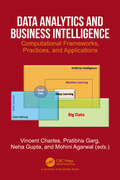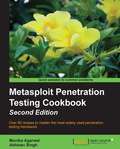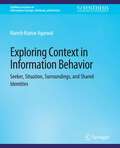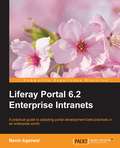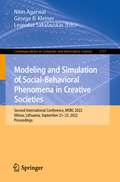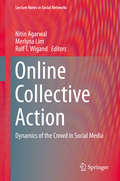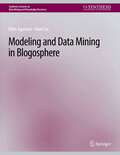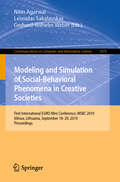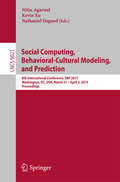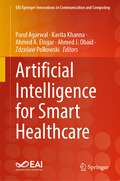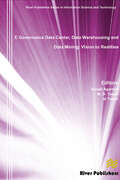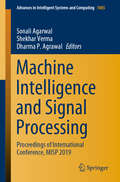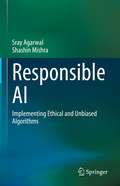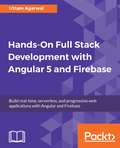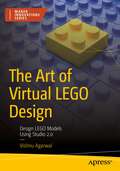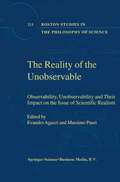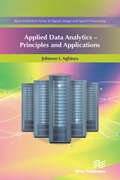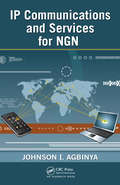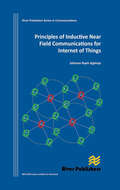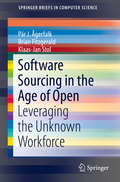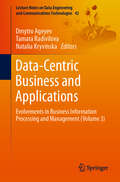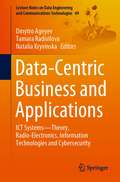- Table View
- List View
Data Analytics and Business Intelligence: Computational Frameworks, Practices, and Applications
by Mohini AgarwalBusiness Analytics (BA) is an evolving phenomenon that showcases the increasing importance of using huge volumes of data to generate value for businesses. Advances in BA have offered great opportunities for organisations to improve, innovate, and develop existing or new processes, products, and services. BA is the process of transforming data into actionable insight by using statistical and mathematical analysis, descriptive, prescriptive, and predictive models, machine learning, information systems and network science methods, among others, along with a variety of data, expert knowledge, and fact-based management to support better and faster decision-making. BA and Business Intelligence (BI) generate capabilities for companies to compete in the market effectively and has become one of the main functional areas in most companies. BA tools are used in diverse ways, for example, to identify consumer behaviour patterns and market trends, to derive valuable insights on the performance of stocks, to find information on the attrition rate of employees, to analyse and solve healthcare problems, to offer insight into inventory management and supply chain management, to analyse data from social networks, and to infer traffic behaviour and develop traffic management policy, among others. BA and BI have become one of the most popular research areas in academic circles, as well as in the industry, driven by the increasing demand in the business world. This book aims to become a stimulus for innovative business solutions covering a wide range of aspects of business analytics, such as management science, information technology, descriptive, prescriptive, and predictive models, machine learning, network science, mathematical and statistical techniques. The book will encompass a valuable collection of chapters exploring and discussing computational frameworks, practices, and applications of BA that can assist industries and relevant stakeholders in decision-making and problem-solving exercises, with a view to driving competitive advantage.
Metasploit Penetration Testing Cookbook
by Monika Agarwal Abhinav SinghIn DetailMetasploit software helps security and IT professionals identify security issues, verify vulnerability mitigations, and manage expert-driven security assessments. Capabilities include smart exploitation, password auditing, web application scanning, and social engineering. Teams can collaborate in Metasploit and present their findings in consolidated reports. The goal of the software is to provide a clear understanding of the critical vulnerabilities in any environment and to manage those risks.Metasploit Penetration Testing Cookbook, Second Edition contains chapters that are logically arranged with an increasing level of complexity and thoroughly covers some aspects of Metasploit, ranging from pre-exploitation to the post-exploitation phase. This book is an update from version 4.0 to version 4.5. It covers the detailed penetration testing techniques for different specializations like wireless networks, VOIP systems, and the cloud.Metasploit Penetration Testing Cookbook, Second Edition covers a number of topics which were not part of the first edition. You will learn how to penetrate an operating system (Windows 8 penetration testing) to the penetration of a wireless network, VoIP network, and then to cloud.The book starts with the basics, such as gathering information about your target, and then develops to cover advanced topics like building your own framework scripts and modules. The book goes deep into operating-systems-based penetration testing techniques and moves ahead with client-based exploitation methodologies. In the post-exploitation phase, it covers meterpreter, antivirus bypass, ruby wonders, exploit building, porting exploits to the framework, and penetration testing, while dealing with VOIP, wireless networks, and cloud computing.This book will help readers to think from a hacker's perspective to dig out the flaws in target networks and also to leverage the powers of Metasploit to compromise them. It will take your penetration skills to the next level.ApproachThis book follows a Cookbook style with recipes explaining the steps for penetration testing with WLAN, VOIP, and even cloud computing. There is plenty of code and commands used to make your learning curve easy and quick.Who this book is forThis book targets both professional penetration testers as well as new users of Metasploit, who wish to gain expertise over the framework and learn an additional skill of penetration testing, not limited to a particular OS. The book requires basic knowledge of scanning, exploitation, and the Ruby language.
Exploring Context in Information Behavior: Seeker, Situation, Surroundings, and Shared Identities (Synthesis Lectures on Information Concepts, Retrieval, and Services)
by Naresh Kumar AgarwalThe field of human information behavior runs the gamut of processes from the realization of a need or gap in understanding, to the search for information from one or more sources to fill that gap, to the use of that information to complete a task at hand or to satisfy a curiosity, as well as other behaviors such as avoiding information or finding information serendipitously. Designers of mechanisms, tools, and computer-based systems to facilitate this seeking and search process often lack a full knowledge of the context surrounding the search. This context may vary depending on the job or role of the person; individual characteristics such as personality, domain knowledge, age, gender, perception of self, etc.; the task at hand; the source and the channel and their degree of accessibility and usability; and the relationship that the seeker shares with the source. Yet researchers have yet to agree on what context really means. While there have been various research studies incorporating context, and biennial conferences on context in information behavior, there lacks a clear definition of what context is, what its boundaries are, and what elements and variables comprise context. In this book, we look at the many definitions of and the theoretical and empirical studies on context, and I attempt to map the conceptual space of context in information behavior. I propose theoretical frameworks to map the boundaries, elements, and variables of context. I then discuss how to incorporate these frameworks and variables in the design of research studies on context. We then arrive at a unified definition of context. This book should provide designers of search systems a better understanding of context as they seek to meet the needs and demands of information seekers. It will be an important resource for researchers in Library and Information Science, especially doctoral students looking for one resource that covers an exhaustive range of the most current literature related to context, the best selection of classics, and a synthesis of these into theoretical frameworks and a unified definition. The book should help to move forward research in the field by clarifying the elements, variables, and views that are pertinent. In particular, the list of elements to be considered, and the variables associated with each element will be extremely useful to researchers wanting to include the influences of context in their studies.
Liferay Portal 6.2 Enterprise Intranets
by Navin AgarwalA practical guide to adopting portal development best practices in an Enterprise world About This Book • Discover the new features and updates in Liferay including the concept of CMS, and collaboration applications with relevant examples and screenshots • Set up the navigation structure for the Enterprise intranet • Full of illustrations, diagrams, clear step-by-step instructions, and practical examples to show you the integration between different applications such as LDAP, SSO, and Liferay Social Office Who This Book Is For This book is for anyone who is interested in the Liferay Intranet Portal. This book is for both beginners and more experienced portal developers who need to create an enterprise intranet portal for their business. It will be handy for IT professionals who know the basics of how the portal technology works and need to integrate different open source technologies. What You Will Learn • Be introduced to the all new features of Liferay 6.2 • Understand the different controls/actions to make the portal work for an Enterprise • Manage users, organizations, sites, user groups, and roles and also set up portal permissions • Set up a forum and get detailed descriptions of categorization, tagging, and Asset Publisher • Enable Wiki to share knowledge among users and create new dynamic data list and poll portlets • Handle federated search and OpenSearch and deploy search-based portlets • Implement web content management with a different approach in the portal • Employ community tools such as invitations, bookmarks, page comments, and page ratings • Manage Liferay's document and media portlet In Detail To develop an intranet portal for an Enterprise, Liferay is the only open-source portal development platform that has a high scale graph for the developer to extend any component. It provides high end integration with other applications. By using this book, both beginners and more experienced users will be able to create an intranet portal easily. This book will be your pocket reference to Liferay. It will explain to you the new features of Liferay, including Liferay Sync and the Recycle Bin. It will help you to integrate with other key applications such as LDAP, SSO, and Alfresco 4.x and above. You will be introduced to documents, web content, and image management. You will move onto Liferay Sync's new tool to synchronize documents and media files to the local system. You'll discover the Market Place, the newest feature of Liferay. Liferay Social Office and its integrations are also thoroughly explained. This book is packed with practical examples that will help you to develop an intranet portal quickly and easily. Style and approach Clear step-by-step instructions to develop an intranet portal for Enterprise. It describes new features and updates in Liferay with clear explanations, and is complete with images, tips, and tricks.
Modeling and Simulation of Social-Behavioral Phenomena in Creative Societies: Second International Conference, MSBC 2022, Vilnius, Lithuania, September 21–23, 2022, Proceedings (Communications in Computer and Information Science #1717)
by Nitin Agarwal George B. Kleiner Leonidas SakalauskasThis book constitutes the joint refereed proceedings of the Second International Conference on Modeling and Simulation of Social-Behavioral Phenomena in Creative Societies, MSBC 2022, held in Vilnius, Lithuania, in September 2022.The 14 full papers and 1 short paper presented were carefully reviewed and selected from 35 submissions. The papers are organized in the following topical sections: simulation of behavioral processes; modeling of sustainability; and data science and modeling.
Online Collective Action: Dynamics of the Crowd in Social Media (Lecture Notes in Social Networks #4)
by Nitin Agarwal Merlyna Lim Rolf T. WigandThis work addresses the gap in the current collective action literature exposed by the new Information and Communication Technologies (ICTs) landscape by bringing together qualitative and quantitative studies from computational and social sciences. The book offers a rigorous and systematic investigation of both methodological and theoretical underpinnings and, thus, collectively promotes a symbiotic and synergistic advancement of the multiple interconnected disciplines in studying online collective actions. More specifically, the book is intended to illuminate several fundamental and powerful yet theoretically undeveloped and largely unexplored aspects of collective action in the participatory media (e.g., social media). Through in-depth exploration of relevant concepts, theories, methodologies, applications, and case studies, the reader will gain an advanced understanding of collective action with the advent of the new generation of ICTs enabled by social media and the Internet. The developed theories will be valuable and comprehensive references for those interested in examining the role of ICTs not only in collective action but also in decision and policy making, understanding the dynamics of interaction, collaboration, cooperation, communication, as well as information flow and propagation, and social network research for years to come. Further, the book also serves as an extensive repository of data sets and tools that can be used by researchers leading to a deeper and more fundamental understanding of the dynamics of the crowd in online collective actions.
Modeling and Data Mining in Blogosphere (Synthesis Lectures on Data Mining and Knowledge Discovery)
by Nitin Agarwal Huan LiuThis book offers a comprehensive overview of the various concepts and research issues about blogs or weblogs. It introduces techniques and approaches, tools and applications, and evaluation methodologies with examples and case studies. Blogs allow people to express their thoughts, voice their opinions, and share their experiences and ideas. Blogs also facilitate interactions among individuals creating a network with unique characteristics. Through the interactions individuals experience a sense of community. We elaborate on approaches that extract communities and cluster blogs based on information of the bloggers. Open standards and low barrier to publication in Blogosphere have transformed information consumers to producers, generating an overwhelming amount of ever-increasing knowledge about the members, their environment and symbiosis. We elaborate on approaches that sift through humongous blog data sources to identify influential and trustworthy bloggers leveraging content and network information. Spam blogs or "splogs" are an increasing concern in Blogosphere and are discussed in detail with the approaches leveraging supervised machine learning algorithms and interaction patterns. We elaborate on data collection procedures, provide resources for blog data repositories, mention various visualization and analysis tools in Blogosphere, and explain conventional and novel evaluation methodologies, to help perform research in the Blogosphere. The book is supported by additional material, including lecture slides as well as the complete set of figures used in the book, and the reader is encouraged to visit the book website for the latest information. Table of Contents: Modeling Blogosphere / Blog Clustering and Community Discovery / Influence and Trust / Spam Filtering in Blogosphere / Data Collection and Evaluation
Modeling and Simulation of Social-Behavioral Phenomena in Creative Societies: First International EURO Mini Conference, MSBC 2019, Vilnius, Lithuania, September 18–20, 2019, Proceedings (Communications in Computer and Information Science #1079)
by Nitin Agarwal Leonidas Sakalauskas Gerhard-Wilhelm WeberThis volume constitutes the proceedings of the First International EURO Mini Conference on Modelling and Simulation of Social-Behavioural Phenomena in Creative Societies, MSBC 2019, held in Vilnius, Lithuania, in September 2019. The 8 full papers and 2 short papers presented were carefully reviewed and selected from 26 submissions. The papers are organized in the following topical sections: computational intelligence in social sciences; modeling and analysis of social-behavioral processes.
Social Computing, Behavioral-Cultural Modeling, and Prediction: 8th International Conference, SBP 2015, Washington, DC, USA, March 31-April 3, 2015. Proceedings (Lecture Notes in Computer Science #9021)
by Nitin Agarwal Kevin Xu Nathaniel OsgoodThis book constitutes the refereed proceedings of the 8th International Conference on Social Computing, Behavioral-Cultural Modeling, and Prediction, SBP 2015, held in Washington, DC, USA, in March/April 2015. The 24 full papers presented together with 36 poster papers were carefully reviewed and selected from 118 submissions. The goal of the conference was to advance our understanding of human behavior through the development and application of mathematical, computational, statistical, simulation, predictive and other models that provide fundamental insights into factors contributing to human socio-cultural dynamics. The topical areas addressed by the papers are social and behavioral sciences, health sciences, engineering, computer and information science.
Artificial Intelligence for Smart Healthcare (EAI/Springer Innovations in Communication and Computing)
by Parul Agarwal Kavita Khanna Ahmed A. Elngar Ahmed J. Obaid Zdzislaw PolkowskiThis book provides information on interdependencies of medicine and telecommunications engineering and how the two must rely on each other to effectively function in this era. The book discusses new techniques for medical service improvisation such as clear-cut views on medical technologies. The authors provide chapters on communication essentiality in healthcare, processing of medical amenities using medical images, the importance of data and information technology in medicine, and machine learning and artificial intelligence in healthcare. Authors include researchers, academics, and professionals in the field.
E Governance Data Center, Data Warehousing and Data Mining: Vision to Realities
by Sonali Agarwal M. D. Tiwari Iti TiwariThis book attempts to disseminate information about several E Governance projects and possible Data Mining benefits which are the future of good governance in India.
E Governance Data Center, Data Warehousing and Data Mining: Vision to Realities
by Sonali Agarwal M. D. Tiwari Iti TiwariThis book attempts to disseminate information about several E Governance projects and possible Data Mining benefits which are the future of good governance in India.
Machine Intelligence and Signal Processing: Proceedings of International Conference, MISP 2019 (Advances in Intelligent Systems and Computing #1085)
by Sonali Agarwal Shekhar Verma Dharma P. AgrawalThis book features selected high-quality research papers presented at the International Conference on Machine Intelligence and Signal Processing (MISP 2019), held at the Indian Institute of Technology, Allahabad, India, on September 7–10, 2019. The book covers the latest advances in the fields of machine learning, big data analytics, signal processing, computational learning theory, and their real-time applications. The topics covered include support vector machines (SVM) and variants like least-squares SVM (LS-SVM) and twin SVM (TWSVM), extreme learning machine (ELM), artificial neural network (ANN), and other areas in machine learning. Further, it discusses the real-time challenges involved in processing big data and adapting the algorithms dynamically to improve the computational efficiency. Lastly, it describes recent developments in processing signals, for instance, signals generated from IoT devices, smart systems, speech, and videos and addresses biomedical signal processing: electrocardiogram (ECG) and electroencephalogram (EEG).
Responsible AI: Implementing Ethical and Unbiased Algorithms
by Sray Agarwal Shashin MishraThis book is written for software product teams that use AI to add intelligent models to their products or are planning to use it. As AI adoption grows, it is becoming important that all AI driven products can demonstrate they are not introducing any bias to the AI-based decisions they are making, as well as reducing any pre-existing bias or discrimination. The responsibility to ensure that the AI models are ethical and make responsible decisions does not lie with the data scientists alone. The product owners and the business analysts are as important in ensuring bias-free AI as the data scientists on the team. This book addresses the part that these roles play in building a fair, explainable and accountable model, along with ensuring model and data privacy. Each chapter covers the fundamentals for the topic and then goes deep into the subject matter – providing the details that enable the business analysts and the data scientists to implement these fundamentals. AI research is one of the most active and growing areas of computer science and statistics. This book includes an overview of the many techniques that draw from the research or are created by combining different research outputs. Some of the techniques from relevant and popular libraries are covered, but deliberately not drawn very heavily from as they are already well documented, and new research is likely to replace some of it.
Hands-on Full Stack Development with Angular 5 and Firebase: Build Real-time, Serverless, And Progressive Web Applications With Angular And Firebase
by Uttam AgarwalBuild an end-to-end application from development to production by binding Angular with Firebase in this complete guide to web application developmentAbout This BookBuild a real-time production-ready web application by leveraging the features of Angular as front end and Firebase as the back endLearn more about authentication, databases, and security with FirebaseLearn how to grow your application user base using Google analytics and how to make your application PWA compliant.Who This Book Is ForThis book is for JavaScript developers who have some previous knowledge of the Angular framework and want to start developing serverless applications with Angular and Firebase. If you are looking for a more practical and less theory-based approach to learn these concepts, then this book is for you.What You Will LearnUnderstand the core concepts of Angular frameworkCreate web pages with Angular as front end and Firebase as back endDevelop a real-time social networking applicationMake your application live with Firebase hostingEngage your user using Firebase cloud messagingGrow your application with Google analyticsLearn about Progressive Web AppIn DetailThis book is a complete package for you to build real-time web applications. You will build an end-to-end social networking web application from development to production with Angular as the frontend and Firebase as the backend.You will create an application called Friends with authentication, friends, and chat features. During the process, you'll use Firebase authentication to register new users and Firebase database to store your extra user data. You'll take a look at how to store and retrieve your user's images from Firebase storage. Then, you'll create a real-time chat module with the Firebase database. Next, you'll secure your database using Firebase security, make your application live with Firebase hosting, and develop your application with analytics.Moving on, you'll take a look at how to create web pages using bootstrap with HTML, CSS, and TypeScript. You will use the angularfire2 library API in Angular services to interact with Firebase and write unit tests using the Jasmine framework that will help you to write a production-ready application. You'll also discover various debugging techniques to troubleshoot any bug in your application. Finally, you'll make your application Progressive Web Applications compliant.By the end of this book, you'll be able to confidently build any complex application.Style and approachThis book takes a practical approach, teaching you to confidently build an end-to-end application from development to production by learning the core concepts of both Angular as a frontend and Firebase as a backend.
The Art of Virtual LEGO Design: Design LEGO Models Using Studio 2.0 (Maker Innovations Series)
by Vishnu AgarwalHave you ever dreamed of designing your own LEGOs? Do you love building huge LEGO models, but don’t have enough bricks? This book will show you how to do all that and more with Bricklink Studio 2.0, a software program that's widely used by LEGO designers to create LEGO models virtually before making them with real LEGO bricks. You'll learn how to start a new project, use the camera control options, and drag and drop parts into your building plate. Then take your bricks from a pile of random pieces into intricate masterpiece models using building tools like Select, Hinge, Clone, Hide, Connect, Collision, and more! You’ll master all the building tools that help you build LEGO models. Then you’ll learn to search and manage LEGO bricks in Studio 2.0 using different palette options like Master, Hidden parts, and Custom parts. Beyond the official LEGO colors, there are special color options you can use to render neon, glow in the dark, and translucent brick. Use this expanded color palette to add to the complexity of your models, and then render your model to see it realistically in 3D! You’ll also learn to animate your model and watch it come to life. After finishing your design, you’ll learn to share what you’ve built with the world. You’ll create professional LEGO instructions for your model that can be printed or shared. Making you a true LEGO design master! What You'll LearnMake fascinating models with virtual LEGO bricks Design LEGO models more efficiently with Studio 2.0’s powerful tools Use “Build Together” simultaneously with another designer on the same project Build massive, amazing models on a small budget Who This Book Is ForAnyone interested in digital modelling or who loves building with LEGOs. Students, hobbyists, and enthusiasts will find fun learning activities.
The Reality of the Unobservable: Observability, Unobservability and Their Impact on the Issue of Scientific Realism (Boston Studies in the Philosophy and History of Science #215)
by E. Agazzi M. PauriObservability and Scientific Realism It is commonly thought that the birth of modern natural science was made possible by an intellectual shift from a mainly abstract and specuJative conception of the world to a carefully elaborated image based on observations. There is some grain of truth in this claim, but this grain depends very much on what one takes observation to be. In the philosophy of science of our century, observation has been practically equated with sense perception. This is understandable if we think of the attitude of radical empiricism that inspired Ernst Mach and the philosophers of the Vienna Circle, who powerfully influenced our century's philosophy of science. However, this was not the atti tude of the f ounders of modern science: Galileo, f or example, expressed in a f amous passage of the Assayer the conviction that perceptual features of the world are merely subjective, and are produced in the 'anima!' by the motion and impacts of unobservable particles that are endowed uniquely with mathematically expressible properties, and which are therefore the real features of the world. Moreover, on other occasions, when defending the Copernican theory, he explicitly remarked that in admitting that the Sun is static and the Earth turns on its own axis, 'reason must do violence to the sense' , and that it is thanks to this violence that one can know the tme constitution of the universe.
Applied Data Analytics - Principles and Applications
by Johnson I. AgbinyaThe emergence of huge amounts of data which require analysis and in some cases real-time processing has forced exploration into fast algorithms for handling very lage data sizes. Analysis of x-ray images in medical applications, cyber security data, crime data, telecommunications and stock market data, health records and business analytics data are but a few areas of interest. Applications and platforms including R, RapidMiner and Weka provide the basis for analysis, often used by practitioners who pay little to no attention to the underlying mathematics and processes impacting the data. This often leads to an inability to explain results or correct mistakes, or to spot errors.Applied Data Analytics - Principles and Applications seeks to bridge this missing gap by providing some of the most sought after techniques in big data analytics. Establishing strong foundations in these topics provides practical ease when big data analyses are undertaken using the widely available open source and commercially orientated computation platforms, languages and visualisation systems. The book, when combined with such platforms, provides a complete set of tools required to handle big data and can lead to fast implementations and applications.The book contains a mixture of machine learning foundations, deep learning, artificial intelligence, statistics and evolutionary learning mathematics written from the usage point of view with rich explanations on what the concepts mean. The author has thus avoided the complexities often associated with these concepts when found in research papers. The tutorial nature of the book and the applications provided are some of the reasons why the book is suitable for undergraduate, postgraduate and big data analytics enthusiasts.This text should ease the fear of mathematics often associated with practical data analytics and support rapid applications in artificial intelligence, environmental sensor data modelling and analysis, health informatics, business data analytics, data from Internet of Things and deep learning applications.
Applied Data Analytics - Principles and Applications
by Johnson I. AgbinyaThe emergence of huge amounts of data which require analysis and in some cases real-time processing has forced exploration into fast algorithms for handling very lage data sizes. Analysis of x-ray images in medical applications, cyber security data, crime data, telecommunications and stock market data, health records and business analytics data are but a few areas of interest. Applications and platforms including R, RapidMiner and Weka provide the basis for analysis, often used by practitioners who pay little to no attention to the underlying mathematics and processes impacting the data. This often leads to an inability to explain results or correct mistakes, or to spot errors.Applied Data Analytics - Principles and Applications seeks to bridge this missing gap by providing some of the most sought after techniques in big data analytics. Establishing strong foundations in these topics provides practical ease when big data analyses are undertaken using the widely available open source and commercially orientated computation platforms, languages and visualisation systems. The book, when combined with such platforms, provides a complete set of tools required to handle big data and can lead to fast implementations and applications.The book contains a mixture of machine learning foundations, deep learning, artificial intelligence, statistics and evolutionary learning mathematics written from the usage point of view with rich explanations on what the concepts mean. The author has thus avoided the complexities often associated with these concepts when found in research papers. The tutorial nature of the book and the applications provided are some of the reasons why the book is suitable for undergraduate, postgraduate and big data analytics enthusiasts.This text should ease the fear of mathematics often associated with practical data analytics and support rapid applications in artificial intelligence, environmental sensor data modelling and analysis, health informatics, business data analytics, data from Internet of Things and deep learning applications.
IP Communications and Services for NGN
by Johnson I AgbinyaRapid deployment and acceptance of broadband networks, including the 802.11 a/b/g, 3G cellular networks, WiMAX, and emerging 4G cellular IP networks, have sparked a growing reliance on voice over IP and the quickly emerging IP TV and Mobile TV. Providing the necessary background and technical understanding to stay abreast of and even ahead of the IP trend, IP Communications and Services for NGN explores IP development for the delivery of next generation mobile services. Packed with detailed illustrations, this cutting-edge reference examines the primary IP protocols (IPv4 and IPv6), real-time protocols, and three major IP services (VoIP, IPTV, and Mobile TV). It clearly explains the different architectures of fixed, mobile, and wireless networks along with the major advantages and disadvantages of each. It includes coverage of the latest in: The VoIP MarketSCTP and Vertical HandoffRSVP: Resource Reservation ProtocolMPLS: MultiProtocol Label SwitchingSIP: Session Initiation ProtocolIMS: IP Multimedia SubsystemRTSP: Real-Time Streaming ProtocolRTP: Real-Time Transport ProtocolIPTV System Architectures and IPTV System Descriptions With a detailed listing of commonly used acronyms, along with a clear description of the role IP is likely to play in the development of next generation mobile services, this book provides educators, industry practitioners, regulators, and subscribers with the ideal starting point for developing the understanding required to deploy, train, and use IP services effectively and efficiently.
Principles of Inductive Near Field Communications for Internet of Things
by Johnson I. AgbinyaNear field communication devices and the emerging field of Internet of things require efficient short range communication techniques. Classical telecommunication theory however has so far focused on radiating electromagnetic signals which is more suited to terrestrial communication systems. Over the last decade however considerable research and applications of inductive methods have emerged as innovative approaches for secure short range communications by changing the paradigm of an established model of electromagnetic communications. We have witnessed the emergence of embedded inductive medical devices, magneto-inductive waveguides, inductive pots and cooking devices, magneto-inductive sensors, wireless power transfer, inductive hearing aids and the emerging inductive point-to-point communication specifically termed near-field communication (NFC) as used in mobile phones and payment cards to name a few. While there exist a large set of distributed methods and algorithms detailing the design and performances of such applications, a significant gap is observed as a lack of detailed collection of the methods in one place which could be easily understood and used quickly by someone seeking to apply the methods.In this book this missing gap is filled with the required details and the theory of near field communication systems including both the radiating and reactive (energy coupling) near-field systems in addition to the well known far field radiation techniques. The book details the fundamental expressions and design methods which facilitate the creation of near field devices and equipment including embedded biomedical implants. The book contains recent advances in inductive communications, performance, limitations and a collection of applications. It also lays a strong foundation for the application of inductive methods for creating Internet of Things systems.
Principles of Inductive Near Field Communications for Internet of Things
by Johnson I. AgbinyaNear field communication devices and the emerging field of Internet of things require efficient short range communication techniques. Classical telecommunication theory however has so far focused on radiating electromagnetic signals which is more suited to terrestrial communication systems. Over the last decade however considerable research and applications of inductive methods have emerged as innovative approaches for secure short range communications by changing the paradigm of an established model of electromagnetic communications. We have witnessed the emergence of embedded inductive medical devices, magneto-inductive waveguides, inductive pots and cooking devices, magneto-inductive sensors, wireless power transfer, inductive hearing aids and the emerging inductive point-to-point communication specifically termed near-field communication (NFC) as used in mobile phones and payment cards to name a few. While there exist a large set of distributed methods and algorithms detailing the design and performances of such applications, a significant gap is observed as a lack of detailed collection of the methods in one place which could be easily understood and used quickly by someone seeking to apply the methods.In this book this missing gap is filled with the required details and the theory of near field communication systems including both the radiating and reactive (energy coupling) near-field systems in addition to the well known far field radiation techniques. The book details the fundamental expressions and design methods which facilitate the creation of near field devices and equipment including embedded biomedical implants. The book contains recent advances in inductive communications, performance, limitations and a collection of applications. It also lays a strong foundation for the application of inductive methods for creating Internet of Things systems.
Software Sourcing in the Age of Open: Leveraging the Unknown Workforce (SpringerBriefs in Computer Science)
by Pär J. Ågerfalk Brian Fitzgerald Klaas-Jan StolThis SpringerBrief discusses multiple forms of open-source-inspired outsourcing: opensourcing, innersourcing and crowdsourcing. It uses a framework-based comparison to explain the strengths and weaknesses of each approach. By pointing out characteristics along with benefits and pitfalls of each approach, the authors provide nuanced and research-based advice to managers and developers facing software sourcing decisions. The differences and commonalities of these three emerging approaches are carefully analyzed. Chapters explore the primary challenges of reliability, efficiency and robustness in open-source methods. Examples from industrial cases are included, along with extensive references to recent research. The brief concludes with a comparative analysis of approaches and outlines key implications to be aware of when outsourcing. Software Sourcing in the Age of Open: Leveraging the Unknown Workforce is designed for professionals and researchers interested in outsourcing challenges. The content is also suitable for postgraduate students interested in contemporary software sourcing approaches.
Data-Centric Business and Applications: Evolvements in Business Information Processing and Management (Volume 3) (Lecture Notes on Data Engineering and Communications Technologies #42)
by Dmytro Ageyev Tamara Radivilova Natalia KryvinskaBuilding on the authors’ previous work, this book addresses key processes and procedures used in information/data processing and management. Modern methods of business information processing, which draw on artificial intelligence, big data, and cloud-based storage and processing, are opening exciting new opportunities for doing business on the basis of information technologies. Thus, in this third book, the authors continue to explore various aspects – technological as well as business and social – of the information industries. Further, they analyze the challenges and opportunities entailed by these kinds of business.
Data-Centric Business and Applications: ICT Systems—Theory, Radio-Electronics, Information Technologies and Cybersecurity (Lecture Notes on Data Engineering and Communications Technologies #69)
by Dmytro Ageyev Tamara Radivilova Natalia KryvinskaThis book, building on the authors’ previous work, presents new communication and networking technologies, challenges and opportunities of information/data processing and transmission. It also discusses the development of more intelligent and efficient communication technologies, which are an essential part of current day-to-day life. Information and Communication Technologies (ICTs) have an enormous impact on businesses and our day-to-day lives over the past three decades and continue to do so. Modern methods of business information processing are opening exciting new opportunities for doing business on the basis of information technologies. The book contains research that spans a wide range of communication and networking technologies, including wireless sensor networks, optical and telecommunication networks, storage area networks, error-free transmission and signal processing.
